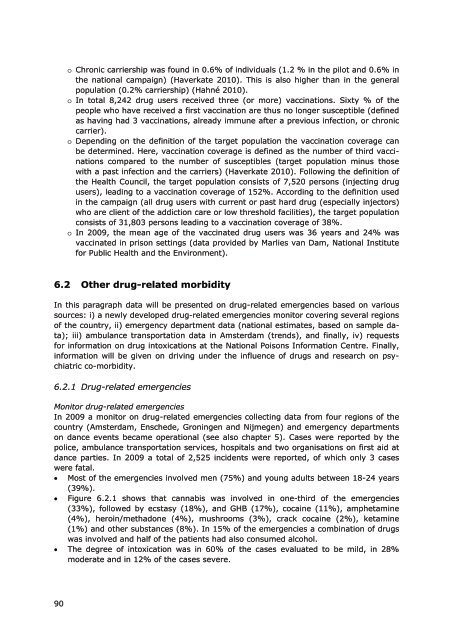The Netherlands Drug Situation 2010 - Trimbos-instituut
The Netherlands Drug Situation 2010 - Trimbos-instituut
The Netherlands Drug Situation 2010 - Trimbos-instituut
You also want an ePaper? Increase the reach of your titles
YUMPU automatically turns print PDFs into web optimized ePapers that Google loves.
o Chronic carriership was found in 0.6% of individuals (1.2 % in the pilot and 0.6% inthe national campaign) (Haverkate <strong>2010</strong>). This is also higher than in the generalpopulation (0.2% carriership) (Hahné <strong>2010</strong>).o In total 8,242 drug users received three (or more) vaccinations. Sixty % of thepeople who have received a first vaccination are thus no longer susceptible (definedas having had 3 vaccinations, already immune after a previous infection, or chroniccarrier).o Depending on the definition of the target population the vaccination coverage canbe determined. Here, vaccination coverage is defined as the number of third vaccinationscompared to the number of susceptibles (target population minus thosewith a past infection and the carriers) (Haverkate <strong>2010</strong>). Following the definition ofthe Health Council, the target population consists of 7,520 persons (injecting drugusers), leading to a vaccination coverage of 152%. According to the definition usedin the campaign (all drug users with current or past hard drug (especially injectors)who are client of the addiction care or low threshold facilities), the target populationconsists of 31,803 persons leading to a vaccination coverage of 38%.o In 2009, the mean age of the vaccinated drug users was 36 years and 24% wasvaccinated in prison settings (data provided by Marlies van Dam, National Institutefor Public Health and the Environment).6.2 Other drug-related morbidityIn this paragraph data will be presented on drug-related emergencies based on varioussources: i) a newly developed drug-related emergencies monitor covering several regionsof the country, ii) emergency department data (national estimates, based on sample data);iii) ambulance transportation data in Amsterdam (trends), and finally, iv) requestsfor information on drug intoxications at the National Poisons Information Centre. Finally,information will be given on driving under the influence of drugs and research on psychiatricco-morbidity.6.2.1 <strong>Drug</strong>-related emergenciesMonitor drug-related emergenciesIn 2009 a monitor on drug-related emergencies collecting data from four regions of thecountry (Amsterdam, Enschede, Groningen and Nijmegen) and emergency departmentson dance events became operational (see also chapter 5). Cases were reported by thepolice, ambulance transportation services, hospitals and two organisations on first aid atdance parties. In 2009 a total of 2,525 incidents were reported, of which only 3 caseswere fatal. Most of the emergencies involved men (75%) and young adults between 18-24 years(39%). Figure 6.2.1 shows that cannabis was involved in one-third of the emergencies(33%), followed by ecstasy (18%), and GHB (17%), cocaine (11%), amphetamine(4%), heroin/methadone (4%), mushrooms (3%), crack cocaine (2%), ketamine(1%) and other substances (8%). In 15% of the emergencies a combination of drugswas involved and half of the patients had also consumed alcohol. <strong>The</strong> degree of intoxication was in 60% of the cases evaluated to be mild, in 28%moderate and in 12% of the cases severe.90




